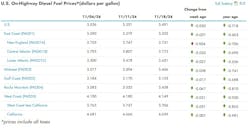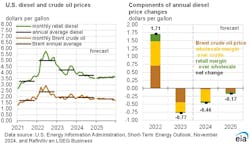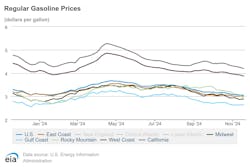Diesel continues to slide under $3.50/gal, gas under $3.05/gal
The U.S. Energy Information Administration found that the U.S. had another promising week for diesel prices, with costs dropping in every region across the country. The U.S. average fell 3 cents to $3.491 per gallon, down 71 cents from this time last year. Otherwise, prices across the country decreased from less than a cent to 6 cents.
In fact, the only exception to the rule the week of Nov. 18 was the subregion of New England, where prices rose less than a cent to $3.751. The East Coast as a whole saw its diesel costs drop 2 cents to $3.552 per gallon. California experienced the smallest price reduction of less than a cent to $4.659, followed by the Gulf Coast with a decrease of 1 cent to $3.153. Both the West Coast and Midwest saw their diesel prices slip 3 cents to $4.149 and $3.466 per gallon, respectively, while the West Coast without California’s diesel prices dipped 5 cents to $3.706. The Rocky Mountains benefitted the most from diesel price drops for the second week in a row, with costs falling 6 cents to $3.458.
With these shifts in mind, the Gulf Coast remains the cheapest place for diesel fuel, while California is the most expensive.
In comparison, the AAA motor club logged diesel costs numbers as 4 cents more expensive than the EIA with a national average of $3.534. This is 1 cent cheaper than last week’s average of $3.548, and 77 cents cheaper than this time last year.
But while prices have continued to drop domestically throughout the U.S., the EIA’s most recent Short Term Energy Outlook is still bracing for upward price pressure due to ongoing geopolitical risk, which may cause more withdrawals from the global oil inventories. Furthermore, the organization anticipates that production cuts from OPEC+ will continue to put upward pressure on oil prices in the next few months as well, potentially pushing the Brent crude oil price to an average of $78 per barrel in Q1 2025.
Both of these factors could increase diesel and gas prices, as the cost of crude oil makes up the bulk of the price of a gallon of fuel. However, at least as far as geopolitical strife goes and the growing conflict in the Middle East, the consequences of potential attacks on suppliers in the region may only be fleeting for the market at large based on past examples of such conflict.
For example, a drone attacked Saudi Arabian refining site Abqaiq, which produced several million barrels of refined product per day, in 2019.
See also: Gas and diesel costs continue incremental decrease, diesel $3.52/gal
“At first, the market thought there could be a tremendous loss,” Matt Muenster, chief economist at Breakthrough, said. “Ultimately, they were able to recover the infrastructure rather quickly, so prices quickly peaked. In the course of a week, they were back down to where they were pre-event.”
As for fuel prices related to OPEC+’s production delay, the EIA also forecast that global oil production will build inventories again in Q2 2025. This could reduce oil prices through the end of the year to $74 per barrel, potentially lowering fuel prices in the second half of 2025.
Gas prices continue to dip across the country
For most regions in the U.S., gas prices continued to decrease along with diesel costs, with the Rocky Mountain region in particular benefitting from fuel price cuts. The national gas average is currently $3.046, a decrease of less than a cent from a week ago and 24 cents lower than this time last year.
Prices rose less than a cent along the East Coast to $3.003 per gallon and by 1 cent in the Midwest to $2.882. On the other hand, prices dropped less than a cent along the Gulf Coast to $2.629 per gallon, 3 cents along the West Coast without California to $3.526, and 4 cents along the West Coast overall to $3.86. In California alone, gas costs decreased 5 cents to $4.196, while gas costs in the Rocky Mountain region dropped 15 cents to $2.917 per gallon. Despite this gain for drivers in the region, the Gulf Coast is still the cheapest place for gasoline, while California remains the most expensive.
In comparison, the AAA gas average is currently at $3.071 per gallon, 3 cents more expensive than the EIA’s estimate and 1 cent less than last week’s average of $3.083 per gallon. The motor club’s current price is also 25 cents less expensive than last year’s of $3.320.
However, AAA is still keeping an eye out for more coastal storms and how they may impact fuel prices.
“Hurricane Rafael fizzled out, but now we are facing the possible formation of Hurricane Sara,” Andrew Gross, AAA spokesperson, said. “Some of the early tracking models have her heading toward Florida by the middle of next week, so stay tuned.”






